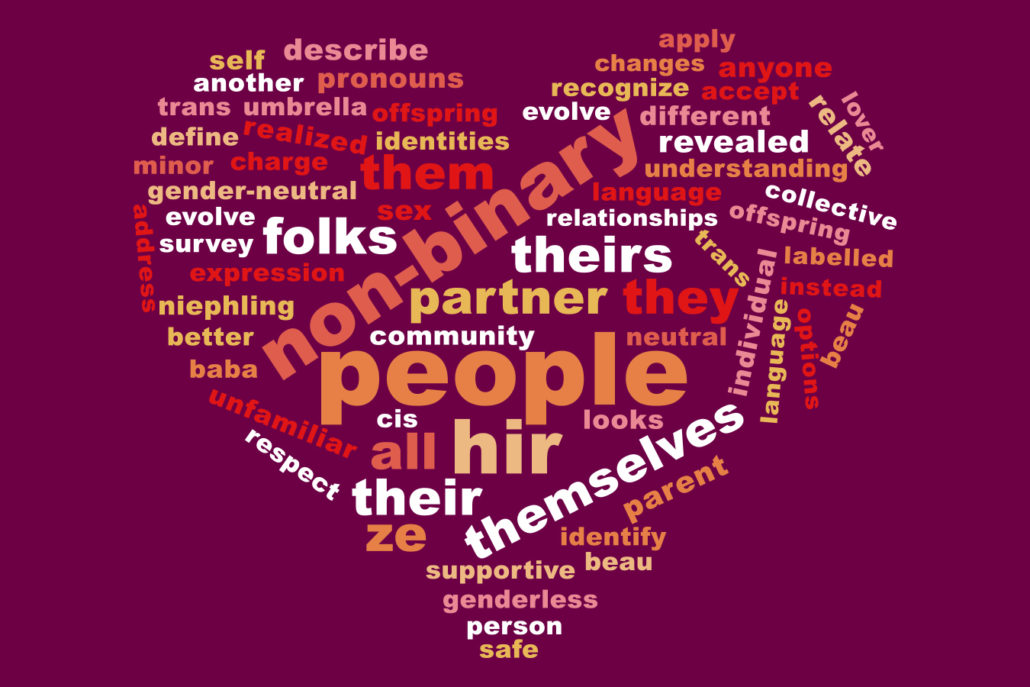
Language defines us in so many ways — here’s how to make sure you’re using it respectfully
I was writing in a café the other day and had to use the washroom. I got up to grab the key and, dangling from the key ring, was a red plastic rhinoceros bottom. On the door to the washroom was affixed the rhino’s better half. Instead of being labeled with pictures of one individual in pants and another in a skirt, both of the cafe’s washrooms were genderless.
As a non-binary person, it made me feel safe. Slowly, societal structures are beginning to recognize those of us who exist outside of the gender binary — the idea that there are two genders, man or woman — and it’s going beyond washrooms. There are endless ways to define one’s gender: Facebook alone recognizes 71 of them. If you live in Canada, passports and immigration documents now have the option of X marking the box for gender, as opposed to the now rather tone-deaf M or F (which relates to sex, not gender, anyway, but that’s a whole other story).
The point of these changes is to make space for people who don’t identify as men or women, but as nonbinary. People who are unfamiliar with concepts of gender variance often feel unsure of how to refer to nonbinary folks or how to use non-binary pronouns, but it’s high time we all learned: Non-binary folks fall under the trans umbrella, and one survey of nearly 28,000 trans people in the U.S. revealed 40 per cent of those surveyed had attempted suicide. The least we can do, as a wider population, is to use language in a way that makes them feel more comfortable and part of the broader community. Here’s how:
Assume nothing
It’s simple: Ask people their pronouns. Before you apply a pronoun to someone, be sure you’re using the right one because misgendering someone can be painful. (Just because someone looks the way you think a man should look does not mean that they are, in fact, a man). If you ask someone and they react angrily, just explain that you ask everyone this question, since there are so many different ways to identify and you don’t want to hurt anyone.
I use “they” as a pronoun, for example. People often assume that I use she/her, and it makes me feel invisible. I was applying for a job recently, and the application asked me to identify my “sex.” Then it told me to pick “man or woman.” Since “sex” refers to someone’s physiology and not the socially constructed manner in which other people determine they should behave, I decided the whole process was reductive as well as inaccurate, and that I wouldn’t apply after all.
Someone’s gender identifier is not part of a conspiracy to commence world domination.
Accept the answer
Many non-binary folks prefer to be referred to by gender-neutral pronouns, like they/them/their or the newer third-person pronouns ze/zir. That said, please don’t assume that someone must use “they” or any other specific gender-neutral or nonbinary pronoun just because they are, or appear to be, non-binary. Related: do not correct a non-binary person and try to give them a language lesson if they open up to you enough to tell you their pronoun. For non-binary people, being clear about who we are usually invites furrowed brows at best and violence at worst, so if someone gives you this much information about themselves, respect it. Language evolves all the time, and it’s evolved to include a new meaning of they/them/their and z.
Realize it’s not about you
It’s crucial not to get frustrated. Trust me: someone’s gender identifier is not part of a carefully plotted leftwing conspiracy to annoy cis people and commence world domination. (“Cis” means the sex you were assigned at birth aligns with your gender expression). The person is just being themselves, and making the conversation about you derails it and may contribute to the feeling that they are not being seen for who they are.
If all else fails
If you don’t have the chance to ask someone’s identifier, use their name. If a pronoun is demanded by circumstance, err on the side of “they,” since it’s neutral and could apply to anyone, cis or trans. (See also: using “folks” when you address a crowd of people instead of “ladies and gentlemen” or “men and women.”) Then, if the person prefers another word, they will likely tell you. If not, you’ve prioritized accuracy and harm reduction, and that’s what this is all about, isn’t it? That, and finding a place where you can pee in peace.